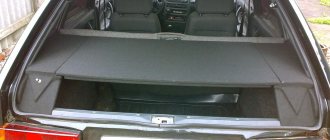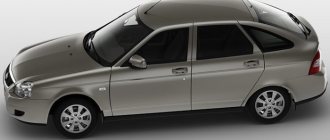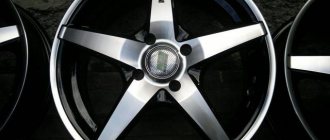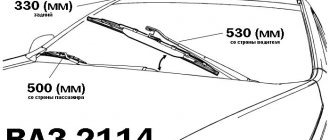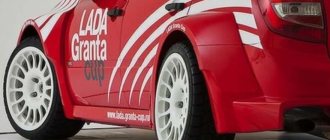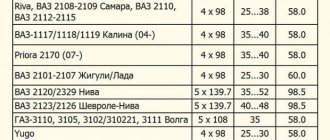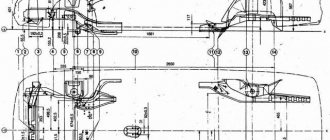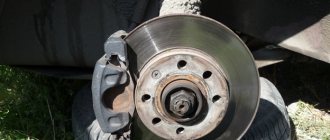VAZ-2109 “Sputnik”/Samara (informal name “Nine”) is a Soviet and Russian front-wheel drive car of group II small class with a hatchback body. Developed and mass-produced at the Volzhsky Automobile Plant in 1987-2004. From 2004 to the end of 2011, the VAZ-21093 version was assembled from vehicle kits in Ukraine. It is a five-door modification of the VAZ-2108 in the Lada Sputnik family of models.
“Nine” “VAZ 2109”
1. Performance characteristics of the VAZ 2109 nine
Maximum speed: 160 km/h Acceleration time to 100 km/h: 13 sec Fuel consumption per 100 km in the city: 10 l Fuel consumption per 100 km on the highway: 5.7 l Fuel consumption per 100 km in the combined cycle: 7.3 l Fuel tank volume: 43 l Vehicle curb weight: 945 kg Permissible gross weight: 1370 kg Tire size: 165/70 SR13
2. Engine characteristics
Location: front, transverse Engine capacity: 1500 cm3 Engine power: 78 hp Number of revolutions: 5400 Torque: 115/3000 N*m Power system: Distributed injection Turbocharging: no Gas distribution mechanism: OHC Cylinder arrangement: In-line Number of cylinders: 4 Cylinder diameter: 82 mm Piston stroke: 71 mm Compression ratio: 9.9 Number of valves per cylinder: 2 Recommended fuel: AI-95
3. Brake system
Front brakes: Disc Rear brakes: Drum
4. Steering
Steering Type: Rack and Pinion Power Steering: No
5. Transmission
Drive: Front Number of gears: manual gearbox – 5 Gear ratio of the main pair: 3.9
6. Suspension
Front suspension: Shock absorber Rear suspension: Coil spring
7. Body
Body type: hatchback Number of doors: 5 Number of seats: 5 Vehicle length: 4006 mm Vehicle width: 1650 mm Vehicle height: 1402 mm Wheelbase: 2460 mm Front track: 1400 mm Rear track: 1370 mm Ground clearance (clearance): 160 mm Maximum trunk volume: 1000 l Minimum trunk volume: 270 l
8. Production
Year of manufacture: from 1987 to 2006
VAZ 2109 – technical specifications, photos
VAZ 2109 (popularly called “nine”) is a Soviet front-wheel drive vehicle of group II small class in a hatchback body.
The model was developed and mass-produced at the Volzhsky Automobile Plant from 1987-2004. From 2004, cars (VAZ-21093) until the end of 2011 were assembled from vehicle kits at the Ukrainian enterprise ZAZ.
This vehicle is also a five-door version of the VAZ-2108 in the Lada Sputnik model division. You can still buy this car on the used car market today. The entire Lada model range.
Rear door lock from Kalina
Skoda Octavia trunk volume in liters
Many car enthusiasts complain about the quality of the standard rear door lock of the VAZ 2109: the trunk lid of the VAZ 2109 does not close well. Knocks and noises while driving are typical. Many problems are caused by the spontaneous opening of the cargo compartment door while moving due to the force created by the door shock absorber. Often, parts of the castle are simply physically destroyed. These problems are typical for all cars of the Samara and Samara-2 families.
This is not the case with Kalina's rear door lock. This car has a lock of a completely modern design with a U-shaped counterpart, like most foreign cars. It opens easily and closes securely. Many owners of “nines” tune the trunk of their “chisel” by installing a lock from the Lada Kalina.
Buy a Kalinovsky lock along with its native counterpart. It fits well on the standard mounting points in the VAZ 2109 body and requires only a little modification: it must be bent 5 mm to the right to accurately fit into the lock guides. The castle itself needs to be adapted to the “nine”.
Since it is not planned to use a manual option for opening the lock with a key through the cylinder, it is necessary to cut off with a grinder or a hacksaw the entire upper area of the structure intended to interact with the cylinder: the vertical part of the hinge and the lock tongue.
CAR HISTORY
Towards the end of the 1980s, AVTOVAZ decided to fill the empty niche of comfortable and versatile family models with the VAZ-2109 car. The fact that the debut domestic mass-produced front-wheel drive car appeared at the Volga Automobile Plant was a significant event not only for the Volga residents, but also for the entire Soviet automobile industry.
It’s a little symbolic, but the start of production of the G8 coincided with a significant event that was celebrated in the fall of 1984 - the 60th anniversary of the automobile industry of the Union of Soviet Socialist Republics. After two years, the original assembly line of the car plant in Togliatti produced a pilot batch of 159 Nine models.
The new version of the “chisel” inherited all the technical innovations from the older model and was able to instantly gain the respect of car lovers. Among all the points, the most important was the “rational” number of doors. However, despite this, a three-door version entered mass production. The logical question arises, why?
Because in a state where personal transport was considered a luxury, and happy car owners felt the transport difficulties of their relatives and friends, the standard 3-volume sedan version was more suitable to the needs of drivers. For a long time, all Soviet mass-produced cars were produced in just such a body.
More productive station wagons, which were produced in small quantities, began to be sold only towards the end of the 1960s, and they were considered in great short supply. There was not a word about other versions of the body: directors of automobile enterprises did not even risk conducting experiments, objectively believing that these programs would not be positively received “at the top.”
But in the case of the G8, everything turned out in the opposite order. At the end of the 1970s, all of Europe was literally overwhelmed by the fashion for hatchbacks. The leaders of the Tolyatti automobile plant, wanting to comply with modern trends, during the design of the new model series, decided to introduce into it, in addition to the standard sedan, 3- and 5-door hatchbacks that were fundamentally fresh for Soviet industrial turnover.
The entry into the foreign market of a new car, designed in accordance with the standards of global trends, was supposed to strengthen VAZ's export positions. The Ministry of Automotive Industry cooled down the ardor of the engineers from Tolyatti a little, calculating the impossibility of financing the production of all 3 versions for assembly line assembly.
In reality, it was possible to free only one line of the factory conveyor for the assembly of 2 standardized modifications. As it turned out, the role of those “lucky ones” was a hatchback, which had a lot of common body elements. As the base version, they decided to choose a cheaper three-door car, and a couple of years later, a five-door car “came to the rescue.”
The sedan version (VAZ-21099) was introduced into mass production only at the end of 1990. Although this delay in a sense benefited the enterprise itself, since with the appearance of the sedan there would have been intense competition with the hatchback version, which was in no way included in the plans of the management of the Volzhsky Automobile Plant.
Body modernization through extension
Technical specifications for the VAZ 2109 all characteristics
In order to protect the body from rapid deformation, today it is customary to simultaneously carry out not only preventive procedures aimed at restoring the original shape, but also tuning. Extending the body of the VAZ 2108 is one of these possibilities.
VAZ 2108 body extension
It is not difficult to expand the body on the G8. It is enough just to stock up on a set of parts for carrying out in accordance with the car model.
The expansion is carried out through:
- Body kits;
- Wings;
- Composite bumpers;
- Wheel arch.
If you are able to carry out this tuning correctly, not only will the appearance of the car improve, which will now look more solid, but the body protection will also increase and the weight of the VAZ 2108 body will decrease, which is undoubtedly important. Especially often today expansion is done using wheel arches
This makes it possible to install much wider wheels or install spacers up to 4 centimeters in size
Widening is especially often done today using wheel arches. This makes it possible to install much wider wheels or install spacers up to 4 centimeters in size.
Tuning VAZ 2108 complete expansion and change
Expansion is also done using plastic linings or by welding metal. Often the part is simply replaced entirely with a tuned one, enhancing the low-slung effect and adding relief to the car.
Tuning is a creative process. If the owner of the G8 is a person close to art, then it is not difficult for him to do something amazing with his car. Here is what he is recommended to do:
- Sketch a future sketch, invented by yourself;
- Try it on directly on the car;
- Transfer the dimensions to the appropriate material (foam or anything else), making a layout;
- Treat the masterpiece with glass mat with added resin;
- Bring the arch to perfection with putty as soon as polymerization is complete;
- Sand, prime and you're done. Yes, we must not forget to paint it at the end.
By the way, the sketch of the future product can be entrusted to a professional designer. He will draw a sketch for you, focusing on the wishes of the car owner.
Approximately according to the same scenario, the body is expanded with other elements. Wide bumpers, additional door trims - all this, together with finished arches, will fit into the new style.
APPEARANCE
From the outside, the VAZ-2109 is an evolution of the Soviet car. Here you can notice the transition to rectangular body lines, which are clearly distinguished by the bow headlights, which are shaped like a trapezoid, as well as a flat-shaped radiator grille and a slightly inclined hood. It was decided to place the turn signal lights on the long front fenders.
After some time, hydraulic headlight range control began to be installed on all “nines”, and some vehicles had a brush headlight cleaner. In 1989, the debut restyling of the “nine” exterior took place, which consisted of a transition from small front wings to longer ones. The most dubious component in the exterior of the G8 and VAZ-2109 was the so-called nasal mask.
It was a fairly complex type of body part, which was adjacent to the hood and wings installed in front. The combined mask area had a beak that protruded forward of the radiator trim. Block headlights were installed on the sides of this unusual structure. Such a pile of elements reduced the already slight elegance of the Soviet car, and the clear lines connecting the cladding to the wings looked unpleasant.
We decided to use only a solid wing, without any “tricks,” which improved the appearance of the VAZ 2109. After this, they installed a new grille, which had two longitudinal stripes in a large frame. After some time, they began to use a new version, consisting of 3 massive stripes, devoid of any frame.
VAZ-2109 with an updated radiator grilleThe side part has the same straight lines of doors and roof, wheel arches and average ground clearance. “Nine” is very similar to its predecessor, the VAZ-2108, which was nicknamed “chisel”. The Soviet hatchback has the same nose shape. Unusually large doors and a thick central pillar add “sporty features” to the model.
On the “nine”, the width of the doors installed in front was reduced from 1,264 to 1,025 millimeters. Thanks to this, the design team was able to incorporate rear doors into the side of the body, the width of which is 885 millimeters. The rectangular rear lights are limited by the line of the luggage compartment lid, which also has a sharp transition at an angle to the roof.
The fifth door received a rear window with a wiper, and the bumpers, along with the side skirts, were made of black plastic (there is a similar bumper in front). The design of the VAZ 2109 has a certain swiftness of lines, but it is very far from a sports car.
Here the developers placed great emphasis on the more practical aspects of the vehicle. When 1987 arrived, the new model mastered the production of plastic gas tanks, which were much lighter and easier to assemble than others. VAZ-2108 and VAZ-2109 already had gas tanks made of steel and plastic.
It is worth admitting that after a while they decided to abandon the production of plastic tanks, as there were problems with the permeability of gasoline vapors.
WEIGHT VAZ 2114
Unreliable weight on the VAZ 2114 or its absence leads to various unpleasant surprises. For example, instead of a turn signal in the rear light, the lights suddenly start blinking (the so-called Christmas tree), or the starter barely turns. If you know where the masses of the VAZ 2114 are located, you can cope with many troubles in the electrical part of the car.
Location of common (mass) wires
The main ground wire is short and thick - it comes from the battery and is attached to a stud with a nut in the area of the front left side member. Its thickness is about 14-16 mm. Also from the negative terminal of the battery there is a thin wire that serves as a power supply to various energy consumers. Weak contact at the terminal leads to rapid discharge of the battery.
The electronic engine control system also requires a common wire. The mass of the ECU on the VAZ 2114 can be mounted in two different places depending on the modification of the car:
- On versions 2115 with a 1.5 liter engine, it is taken from the engine (two M6 bolts on the rear camshaft plug).
- On 1.6 liter internal combustion engines, as well as 1.5 liter engines with a Bosch or “January” version 7.2 ECU, it is fixed with a bolt screwed to the metal frame of the center console under the dashboard.
If the common wire of the electronics does not make good contact with the car body, then the ECM on the VAZ 2114 may cause various malfunctions.
Please note that the wire must be well secured
Where is the mass of the VAZ 2114 instrument panel located? There is only one common mass point in the cabin for the instrument panel wiring, luggage compartment wiring harness and fuse box circuit (models 2108-09 and 2113-2114-2115), it is located under the instrument cluster near the steering column.
The heater motor also requires a minus. It is attached to the heater body on the driver's side of the cabin.
The question remains - where is the mass of the VAZ 2114 engine. The mass is precisely the place where the main negative terminal of the battery is attached to the body.
INTERIOR
The interior decoration of the VAZ is reminiscent of the minimalism of the 1980s. The instrument panel and dashboard create an almost right angle. There are only 3 types of panels: “low”, “high” and “European”. If we talk about the quality of the plastic used as finishing, then it is far from ideal.
Of course, by installing plastic in the interior of the Nine, it was possible to reduce the weight of the car, but on the other hand, it deprived VAZ cars of that touch of luxury that the Zhiguli of the classic division is remembered for. If you look at it differently, the ergonomic level is not bad, so you don’t have to be distracted from driving the vehicle on the road.
This was partly achieved through the compact arrangement of controls. Inside the steering wheel there is one curved cross member with a horn button. Airbags are not provided by the factory. In general, the interior of the VAZ-2109 is purely practical with claims to the level of comfort.
Despite the laconic “low” instrument panel, it is quite comfortable. Although many liked the high panel 2109. The seats installed in front received headrests. In addition, the front seats have upper seat belt attachment points that are height adjustable.
The elastic seats provide good body support. But a tall driver will lack the choice of adjusting his seat in the longitudinal plane. The rear sofa, although designed for three passengers, can only accommodate two people comfortably.
Do not forget that their height should be no more than 175 cm. The luggage compartment volume of the Soviet hatchback is quite modest 270 liters of usable space (the more practical platform version already received 400 liters).
Basic faults
Almost all VAZ 2109 engine failures, no matter what type it is, are associated with malfunctions of 3 systems:
- Lubrication systems.
- Cooling systems.
- Gas distribution systems.
In cases where the lubrication system is faulty, the engine oil does not lubricate the rubbing parts well, which causes them to wear out quickly, scuffs appear on their surfaces and a knocking noise occurs in the engine. Any knocking noise in the VAZ 2109 engine is a very bad sign, especially when it comes from below. If the main or connecting rod bearings are knocking, you must immediately stop and go to the service station in tow, since otherwise the engine may simply jam. If the source of the knock is located in the cylinder head, then you can go to the service center yourself, at low speeds.
If the cooling system malfunctions, the power unit overheats, as a result of which the cylinder head gasket and valves burn out, the cylinder head becomes bent and the piston rings become stuck. If there is severe overheating, the block may simply jam. The main malfunction of the timing mechanism is a broken drive belt. Since on 1.1- and 1.3-liter engines a broken timing belt leads to bending of the valves and major repairs of the head, it needs to be changed every 30-60 thousand kilometers, regardless of the condition. This repair is very simple:
- First, the engine protection is unscrewed.
- Then the alternator belt is removed.
- After this, 3 bolts are unscrewed and the front timing drive cover is removed.
- Next, the mark on the camshaft pulley is aligned with the mark on the rear drive cover.
- After this, the nut is unscrewed and the crankshaft pulley is removed.
- Then the nut securing the tension roller is loosened. It is moved to the side, and the toothed drive belt is carefully removed first from the camshaft pulley, and then from all other pulleys.
- The new belt is placed first on the crankshaft sprocket, then on the camshaft pulley, and only then on the pump gear and tension roller.
- After this, the crankshaft pulley is screwed on and the belt is tensioned by turning the roller and tightening its nut.
Standard tuning of the VAZ 2109 carburetor power unit involves installing an injector. And on injection engines you can install lightweight connecting rods, pistons and a crankshaft with a flywheel.
Source
TECHNICAL CHARACTERISTICS VAZ 2109
ENGINE
In the role of motors, domestic engineers used various power plants with different volumes and power. The very first Soviet-made models came with a 1.1-liter engine.
The basic version of the “nine” was equipped with a 4-stroke, eight-valve, four-cylinder power unit of the “eight”, the displacement of which was 1,295 cubic centimeters. This “engine” developed 64 horsepower at 5,600 rpm. Peak torque (94 Nm) reached after 3,400 rpm.
The speed limit was 148 kilometers per hour. The first hundred was reached in 16 seconds. Such a modest engine consumed about 8.7 liters per hundred kilometers in city mode and 5.7 liters outside the city.
Option 21093 already has a carburetor engine 21083. It has a volume of 1,499 cubic centimeters. Maximum power of 69 “horses” is achieved after reaching 5,600 rpm. The maximum torque is 106.4 Nm already at 3,500 rpm. The Soviet hatchback can accelerate to 155 kilometers per hour, and the first hundred is reached in 15 seconds.
It is logical to conclude that as power increases, gasoline consumption also increases. So, in the city this figure remains at 8.6 liters per hundred kilometers, and on the highway it drops to 5.9 liters per 100 kilometers. The VAZ 2109 carburetor was called “Solex” and was a new, more economical model.
The most compact is considered to be the 1.1-liter engine, developing only 54 “horses”, which were available at 5,600 rpm. Maximum torque of 79 Nm is available at 3,600 rpm. The maximum speed does not exceed 155 kilometers per hour, and fuel consumption in combined mode is about 6.7 liters per 100 kilometers.
In addition, later they began to produce the VAZ 2109 engine with an injector. It received the index 211180 and was installed in the VAZ-21093i and 1.5 liter volume. This power unit is capable of producing 72 horsepower, available at 5,600 rpm.
Peak torque of 118 Nm is available at 2,800 rpm. For every 100 kilometers, the fuel consumption of the VAZ 2109 is 8.0 liters in the city and 5.8 liters on the highway.
In the injection version of the engine, injectors very often fail, but you can repair them yourself or have them repaired by specialists. This video explains well how to clean and rinse the injectors yourself.
TRANSMISSION
The gearbox for the hatchback initially came with four speeds, but since 1989, the engineering staff decided to introduce a five-speed manual transmission. This transmission has a single-plate simple clutch, a cylindrical final drive, a bevel differential and drive shafts with CV joints.
There is also an integrated center spring and cable drive. The VAZ 2109 gearbox is not very complicated, so some even undertake to repair it on their own.
The design of the Soviet front-wheel drive hatchback has an interesting feature. In order to engage reverse gear, move the gearshift lever all the way to the left and forward. Almost the same principle applies to turning on the first speed.
CHASSIS
At the front, they decided to install a fully independent McPherson-type suspension, which is also called a “floating spark plug.” At the rear they installed a semi-independent suspension with a transverse beam that works on torsion.
In its structure, such a beam is similar to numerous front-wheel drive cars of past years. Hydraulic shock absorbers, cylindrical springs, as well as lower wishbones with braces and a stabilizer bar are used.
As a braking device for a front-wheel drive car, disc brakes with movable calipers in front and drum mechanisms in the rear are used. The distance between the disc and the pad is adjusted automatically. The brake drive of the machine is represented by the hydraulic method.
SAFETY
The dashboard takes impacts tightly. The controls, along with the headrests and other elements, were made of soft plastic. The factory provided sun visors, so as not to blind the driver, which were covered with cladding. Additional sun protection is provided by easily adjusting the placement of the interior mirror.
The plant workers provided a system of mutually moving elements that absorb the impact force, combined with a carriage that moves to one side, which, using an adjustable delay, reduces the collision energy with the steering wheel. The aspherical concave external mirror increases the viewing range.
Estimating the distance to the car following behind will only be symbolic, since there is a slight distortion. The designers of the VAZ 2109 provided seat belts not only in the front seats, but also for those sitting in the rear. Such an element can save more than one life!
The car received three-point seat belts, with an automatically winding device and a locking device, which provides full independence of activity at a calm speed mode, while at the same time clasping the torso tightly and with tension.
During strong acceleration or deflection of the machine, the belt is quickly locked in all directions. This option is not tested by special sudden movements of the body.
Engine weight and other characteristics
The lightest is the latest engine model 11183-20 - it weighs 112 kilograms.
The remaining modifications are heavier (almost 128 kilograms). Interestingly, the lightest modification in weight is the most powerful - it has 81 horsepower. The first power plants were much more modest in parameters - the 2108 had only 64 hp. s., and 21083 has 69 “horses”. What the power units have in common is the number of cylinders - all are equipped with four. Moreover, the first modification has a cylinder diameter of 76 millimeters, and subsequent modifications have a cylinder diameter of 82 mm. By volume, the engines have the following parameters:
- 2108 – 1.3 liters;
- 21083 – 1,5;
- 2111 – 1,6.
Engine 21081 was similar in basic parameters to the base one, but had low power - only 54 horsepower. An intermediate option, before the start of production of cars with a power plant from Kalina, was the injection 2111-80. The number of “horses” in it increased to 72, and the maximum speed reached 160 km/h.
PRICE AND EQUIPMENT
The “nine” did not have a special level of comfort, so there is simply nothing to describe to a greater extent. Even then, it was in many ways superior to foreign cars. But the domestic hatchback was distinguished by its maintainability and the presence of the necessary parts.
The steering wheel did not have a hydraulic booster, so you had to physically work hard. There was a standard heater, a simple steering wheel and standard seats with seat belts installed.
It was possible to adjust the external mirrors from the interior using a mechanical lever. Today, the VAZ 2109 can only be purchased on the secondary market. Usually the price tag for this car is low, so you can buy a car on the go from 60,000 rubles.
Where is the speed sensor located?
The speed sensor (DS) on front-wheel drive VAZ cars reads pulses depending on wheel speed and transmits the data to the electronic control unit (ECU). When braking the engine, the fuel supply is turned off with the help of the diesel engine and the computer, thus achieving more economical operation of the internal combustion engine. If the sensor is faulty, an error code is recorded, gasoline consumption increases slightly, and idle speed decreases, especially during heavy braking. It is difficult to immediately detect where the speed sensor is located, since it is hidden under the air filter housing (AFC).
We find the part we need as follows:
- open the hood of the car;
- Using a 10mm wrench, unscrew the two KVF fastening bolts;
- loosen the clamp of the air “corrugation”, disconnect the “chip” with the wires;
- we take out the KVF, now the sensor has already appeared in the field of view, it is located on the gearbox (gearbox) housing, wires are connected to it, connected using a connector.
OWNERS' REVIEWS
Despite the rather outdated model, appearance and low dynamic performance, as well as the low level of comfort, many motorists speak quite well about the “chisel”. I am pleased with the simplicity and inexpensive maintenance. Parts can be purchased for the best possible price, and also at a flea market. You can repair it yourself. The car is ideal for tuning.
The unpretentiousness of the car is known to many. Positive reviews include fairly acceptable fuel consumption, at the level of 8-10 liters in the combined cycle. Summer residents can especially be pleased with the good ground clearance, which allows them to confidently drive over uneven surfaces and not be afraid of bumpy roads.
It’s bad that there is no hydraulic power steering, so you have to make physical efforts to control the car, especially while standing still. Inside, people can comfortably fit only in the first row of seats. For the second row there is not much free space left in the legs and above the head. It’s not very comfortable for the three of us to sit, and the transmission tunnel running in the center clearly causes discomfort.
According to reviews from VAZ 2109 owners, the hatchback’s heater works strangely; at first the interior is filled with cold air, and only then warm air begins to flow in. The quality of the interior is very mediocre, the plastic is cheap, you can hear crickets everywhere, and there are noticeable large gaps between the panels. The power unit very often lacks power, so you have to spin the engine up to 4,000 rpm.
If desired, it would be possible to install air conditioning, but the engine is very weak, so the question disappears. Safety is also far from ideal, so if there is a serious accident, at best you can get away with injuries. Only recently, domestic cars began to be equipped with many systems that ensure safety, but this, of course, did not affect the VAZ 2109 in any way.
Description
The technical characteristics at that time were standard: a 1.1-liter engine, a carburetor in the mechanisms, a maximum power of 54 horsepower.
After some time, models of this car with an improved engine began to appear on sale. The main changes include a larger engine volume, increased to 1.5 liters, and an engine temperature sensor, and in the early 2000s, models with an injector entered mass production. It is also possible to perform engine tuning in the VAZ 2109, which allows you to obtain improved performance for relatively little waste.
The main advantage of this machine was its fairly cheap maintenance, which was typical for any of the production machines.
Even after the end of the warranty period, keeping the car in good condition was quite simple and did not require any special expenses, the main thing was to change the oil regularly. And thanks to the prevalence of this range of models, it is quite easy to find replacement parts for broken ones both in car repair shops and in the hands of motorists.
Due to the simplicity of the design, many owners thought about what kind of engine they could install to improve the car’s performance. In order to repair or tune a VAZ 2109 engine, you do not have to be a car mechanic.
Almost any driver can do all the work with his own hands. That is why most owners of this car want to drive this model, which is cheap both to repair and to operate, for as long as possible. Tuning the VAZ 2109 engine is also easy.
To better understand the topic, it is important to consider a couple more examples.
How much does a VAZ 2107 weigh for scrap metal? Its mass ranges from 1030 to 1060 kg. If you subtract 30%, it turns out that the owner of the vehicle will only be paid 721-751 kg of scrap metal.
ADVANTAGES AND DISADVANTAGES
ADVANTAGES OF THE MACHINE
- Inexpensive Soviet-made car;
- Front-wheel drive can certainly be considered an advantage;
- Acceptable ride height;
- Good dynamics, high speed, pleasant handling and sufficient stability on different surfaces;
- Heating and ventilation cope well with their tasks and supply air to several points at once, which improves the uniform distribution of thermal air throughout the cabin;
- Acceptable fuel consumption;
- Ideal for tuning;
- Availability of spare parts and good maintainability.
DISADVANTAGES OF THE CAR
- Corrosion of metal;
- The appearance is clearly not for everyone;
- A small resource of some details;
- Mediocre sound insulation of the cabin;
- Low equipment;
- There is very little free space, especially for rear passengers;
- Small luggage compartment;
- Poor maneuverability;
- Poor quality interior;
- Low level of security;
- The power unit clearly lacks power.
Body geometry of the VAZ 2108 — DRIVE2
Technical characteristics and dimensions of Niva 21213; 21214; 2131. Lada 212140 technical specifications. technical characteristics of Lada 212140
Data on the geometry and control points of the VAZ 2108 -2109 from the factory documentation. A selection of geometric dimensions of the body, data on the geometry of the body and control points of the VAZ 2108 -2109 from the factory documentation.
1 — right front spar; 2 — right front fender mudguard; 3 — connector of the wind window frame and sidewall; 4 — hood; 5 — lower middle reinforcement of the wind window frame; 6 — upper side panel; 7 — right outer side panel; 8 — front lower roof beam; 9 — inner side panel; 10 — wind window frame; 11 — connector of the sidewall and front; 12 — rear wheel arch; 13 — extension of the outer side panel; 14 — rear right sidewall plug; 15 — internal pillar of the wind window frame; 16 — roof panel; 17 — roof reinforcement; 18 — amplifier of the central pillar; 19 — drainage channel; 20 — left outer side panel; 21 — rear roof beam; 22 — tailgate; 23 — groove of the tailgate opening; 24 — rear panel; 25 — extension of the outer side panel; 26 — front door; 27 — lower sidewall trim; 28 — rear floor cross member; 29 — rear floor; 30 — rear wheel apron bracket; 31 — plate of the rear spar amplifier bolt; 32 — spar reinforcement for the rear suspension arm; 33 — rear spar amplifier extension; 34 — spar reinforcement for the jack bracket; 35 — rear floor spar; 36 — middle floor crossbar; 37 — connector of the rear spar and front floor; 38 - middle floor; 39 — amplifier of the front side pillar; 40 — floor reinforcement for installing a jack; 41 — vertical insulating gasket of the front wing; 42 — front floor cross member; 43 — front seat bracket; 44 — front floor; 45 — floor reinforcement for fastening the gear shift lever; 46 — floor threshold connector; 47 — front wing; 48 — horizontal insulating gasket of the front wing; 49 — battery platform; 50 — left front fender bracket; 51 — front panel; 52 — left front fender mudguard; 53 — left front spar; 54 — radiator frame stand; 55 — upper cross member of the radiator frame; 56 — headlight mounting bracket; 57 — front suspension bracket of the power unit; 58 — lower cross member of the radiator frame; 59 — radiator frame panel; 60 — left reinforcement of the lower cross member of the radiator frame with an eye for towing
Geometry check: factory dimensions
VAZ 21083 body dimensions and VAZ 2109 photo dimensions
Geometry is the exact dimensions of the VAZ 2108 body. And when checking, the most important of them come forward. As a rule, one of the main parameters of the body is the size of the side member, wheelbase, distance between the wheels on one axle, etc.
No less important is the distance between the points of the door and window openings, the location of the internal combustion engine compartment, the dimensions of the trunk, and so on.
VAZ 21083 body dimensions are correct
The table below shows the original, factory dimensions of the V8 body, which will make it possible to check the metal frame for deformation and find out how much the VAZ 2108 body weighs, which is also important
Engine dismantling
https://www.youtube.com/watch?v=5M7jgz9IVhI
You can reduce the weight of the power plant if you remove it without:
- Gearbox (its weight is about 30 kilograms);
- a head weighing approximately 10 kilograms.
As a rule, at service stations, power units are removed assembled with the gearbox, while during self-repair, dismantling is carried out without attachments.
Let's give an example of engine dismantling, which is described in the car's operating instructions. The peculiarity of the work in this case is that the engine is removed through the bottom of the car. The manufacturer recommends not to disconnect the box from it, but to install the car itself on a lift.
- Disconnect the terminals and then remove the battery.
- Drain the coolant and engine oil.
- Remove the crankcase protection.
- Disconnect the muffler and remove the air filter.
- Loosen the brake booster hose clamp that leads to the powertrain inlet pipe.
- Unhook the ground from the crankcase; to do this you will need to unscrew the fasteners.
- Remove the high-voltage wire from the central contact of the distributor cover.
- Using a screwdriver, turn the spring clip and remove the block with the wires coming from the contact socket of the distributor.
- Remove the fuel hose.
- Remove the clutch cable end from the clutch drive lever.
- Disconnect the wires from the traction relay, from the generator output and from the carburetor shut-off valve.
- Disconnect the air supply hoses to the throttle and the fuel hoses leading to the carburetor.
- Remove the spring from the throttle actuator.
- Remove the speedometer and accelerator drive cables from the valve covers.
- Unhook the block with the wire from the economizer, remove the oil pressure and liquid temperature sensors in the cooling system.
- Remove the heater outlet hose and transmission drive rod.
- Next, you will need to disconnect the remaining conductors from the box and move the drive shafts to the side.
- After the steering rod and other parts are disconnected, place a stand under the engine and unscrew the nuts of the rear mounting support, then the right front and left.
Before lowering the engine, check that you have disconnected everything from it. In order to remove the engine from under the car, you need to lift the front part of it.
The 5-speed manual transmission VAZ 2109 was produced at a plant in Tolyatti from 1987 to 2005 and was installed on all numerous front-wheel drive AvtoVAZ models on the 2108-09 platform. This transmission is designed for torque of power units up to 1.6 liters and 120 Nm.
The ninth family also includes 5-speed manual transmissions: 2113, 2114 and 2115.
